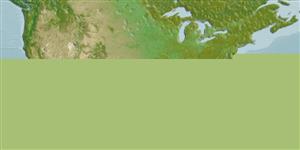Common names from other countries
Environment: milieu / climate zone / depth range / distribution range
Écologie
marin; saumâtre démersal; profondeur 1 - 43 m (Ref. 89891). Subtropical; 37°N - 9°N, 98°W - 59°W
Western Atlantic: Virginia to Texas in USA, northern Mexico, south to Trinidad and Tobago.
Taille / Poids / Âge
Maturity: Lm ? range ? - 35 cm
Max length : 83.0 cm TL mâle / non sexé; (Ref. 40637); common length : 50.0 cm TL mâle / non sexé; (Ref. 3275); poids max. publié: 9.3 kg (Ref. 4699); âge max. reporté: 8 années (Ref. 46275)
A cryptic species that tolerates low salinities; occurs frequently in brackish bays and estuaries, even on occasion in fresh water (Ref. 9988). Minimum depth is at 0.7 meters (Ref. 128969). Adults are found mostly over mud bottoms in estuaries and coastal waters to about 40 m depth. Taken by anglers inshore from bridges, jetties and small boats. They move to deeper water in winter, but are still easily accessible (Ref. 9988). Adults feed chiefly on fishes, also on crabs and shrimps. Juveniles take mainly small bottom-living invertebrates. Marketed fresh and frozen; eaten steamed, fried, boiled, microwaved and baked (Ref. 9988).
Distinct pairing (Ref. 205).
Robins, C.R. and G.C. Ray, 1986. A field guide to Atlantic coast fishes of North America. Houghton Mifflin Company, Boston, U.S.A. 354 p. (Ref. 7251)
Statut dans la liste rouge de l'IUCN (Ref. 130435)
CITES (Ref. 128078)
Not Evaluated
Menace pour l'homme
Harmless
Utilisations par l'homme
Pêcheries: commercial; pêche sportive: oui
Outils
Articles particuliers
Télécharger en XML
Sources Internet
Estimates based on models
Preferred temperature (Ref.
115969): 23.2 - 24.9, mean 23.9 (based on 168 cells).
Phylogenetic diversity index (Ref.
82804): PD
50 = 0.5000 [Uniqueness, from 0.5 = low to 2.0 = high].
Bayesian length-weight: a=0.00575 (0.00365 - 0.00908), b=3.19 (3.06 - 3.32), in cm Total Length, based on LWR estimates for this species & Genus-body shape (Ref.
93245).
Niveau trophique (Ref.
69278): 3.5 ±0.48 se; based on food items.
Résilience (Ref.
120179): Milieu, temps minimum de doublement de population : 1,4 à 4,4 années (K=0.21-0.23; tmax=8).
Fishing Vulnerability (Ref.
59153): Moderate vulnerability (44 of 100).
